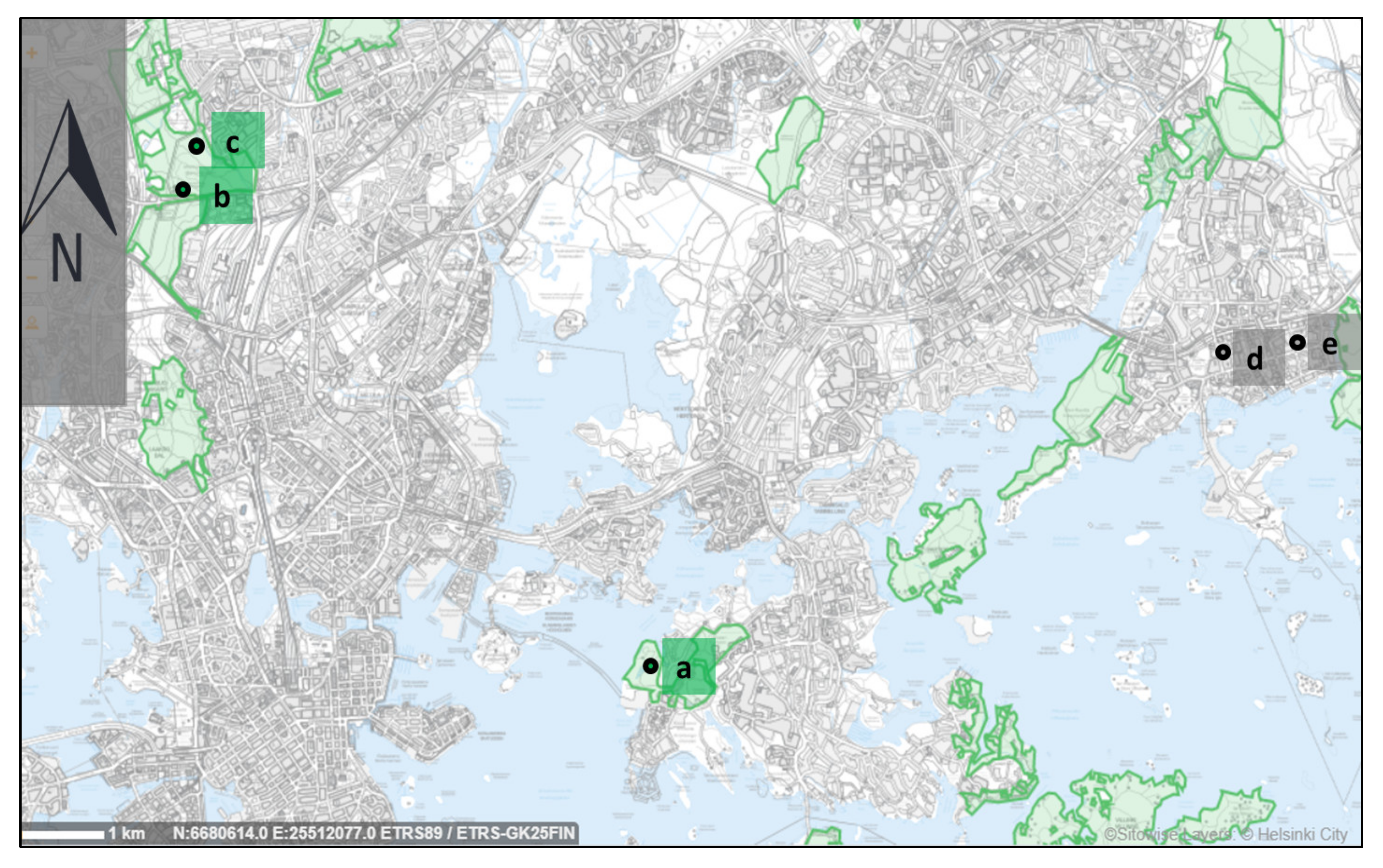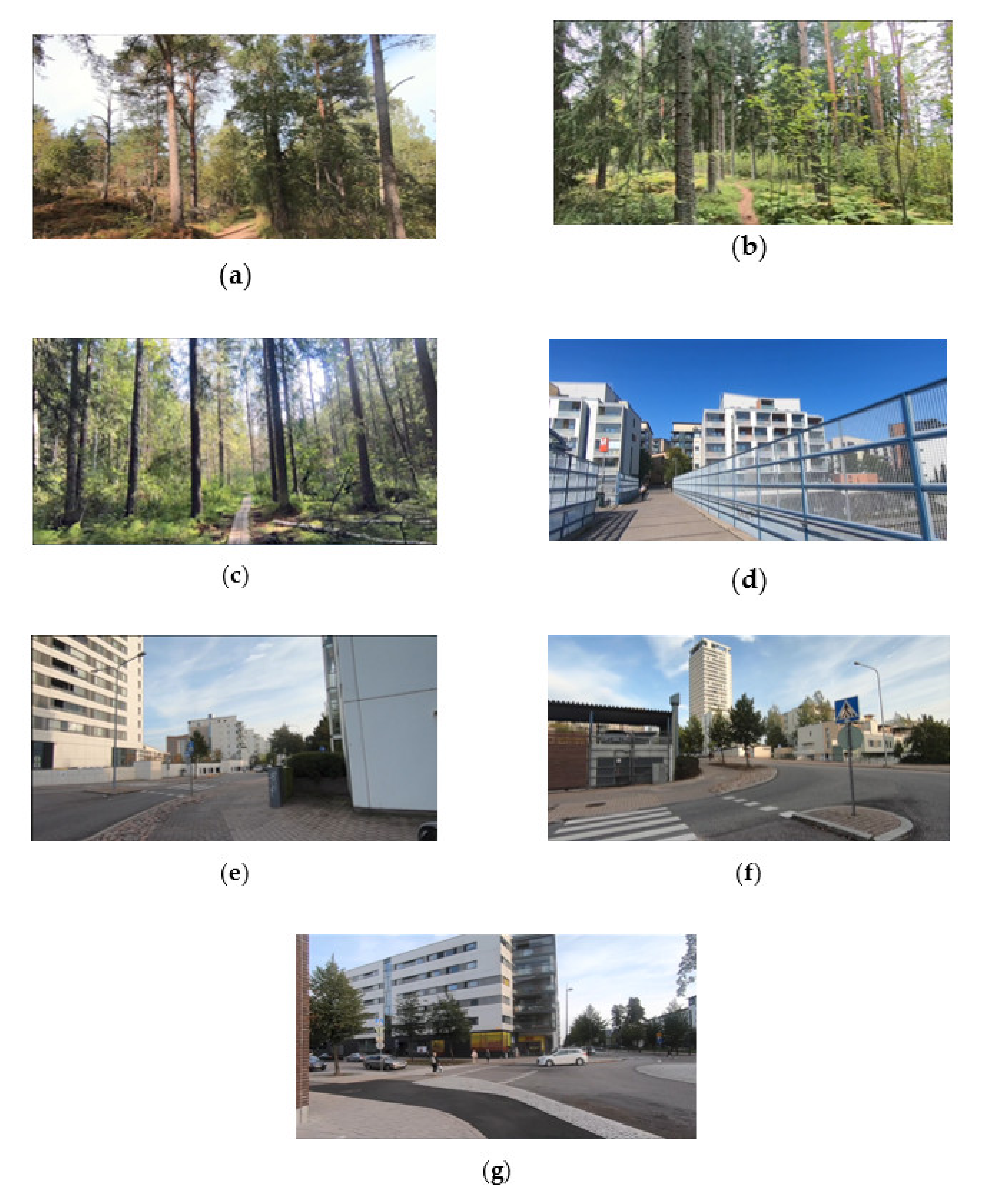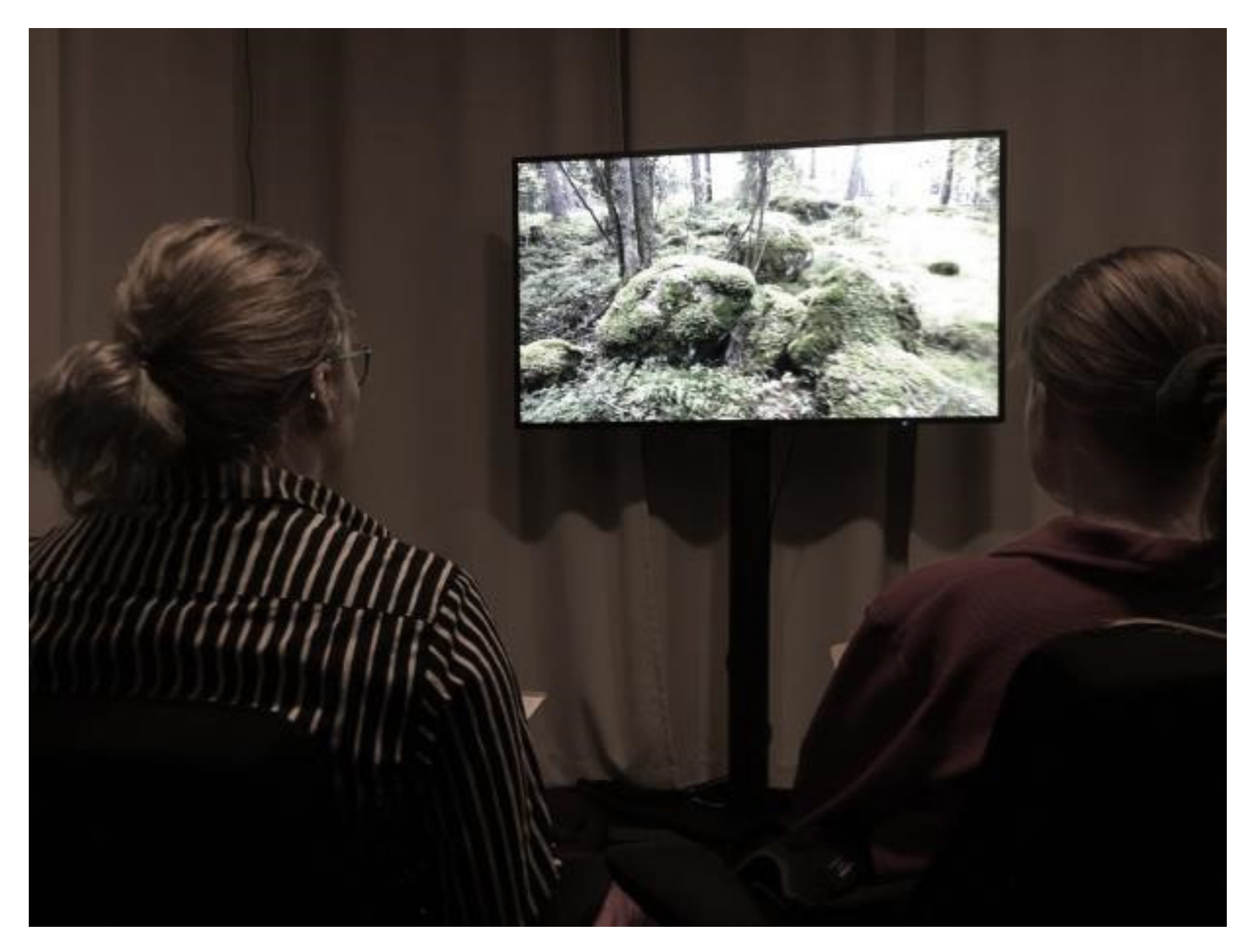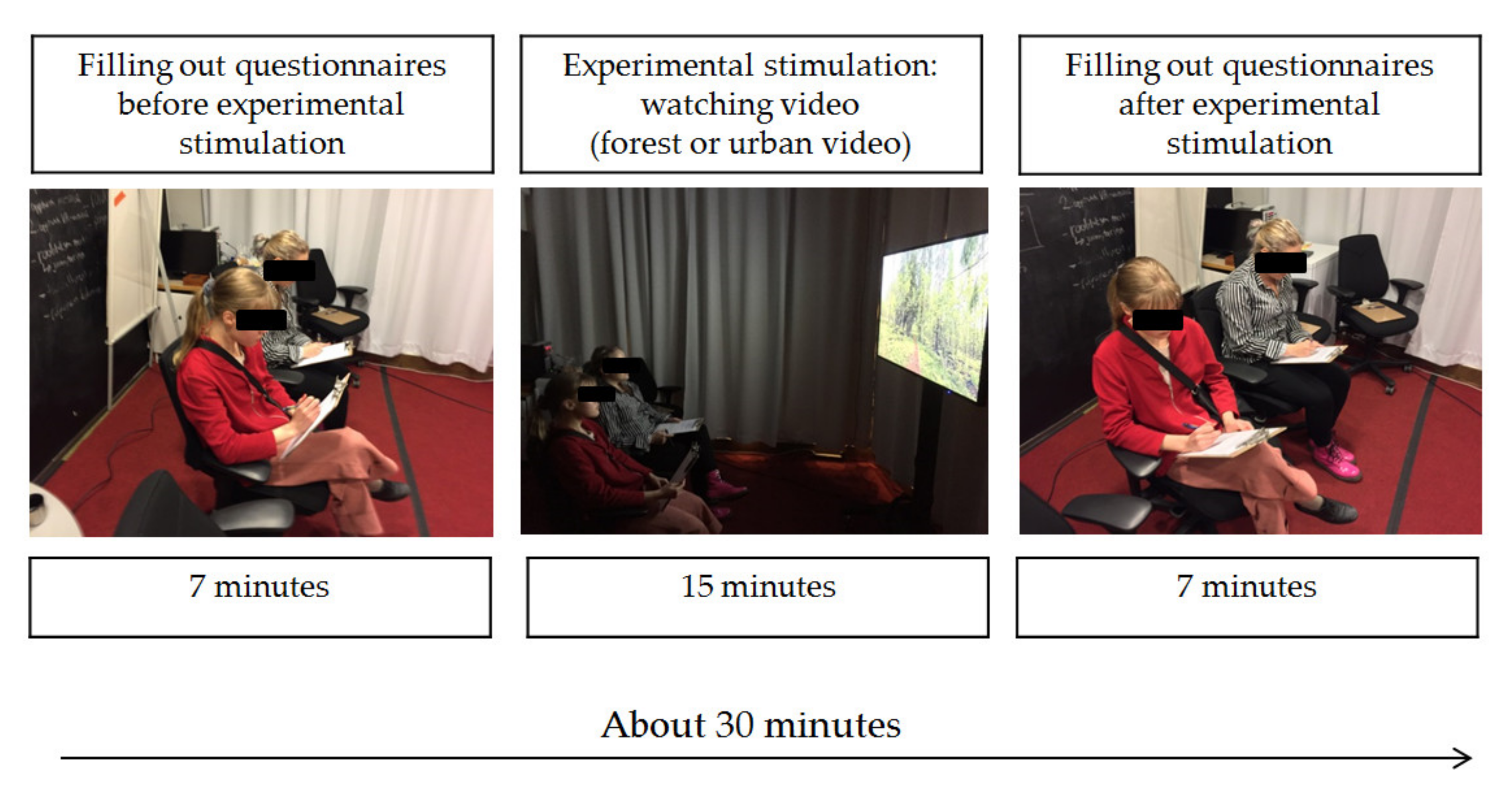2.1. Subjects
The study participants were 42 healthy volunteer students (23 women, 19 men), with an average age of 26.24 ± 6.23 (mean ± SD) years. Of these, 40 subjects studied at the University of Helsinki, and two studied at the University of Turku. We aimed at recruiting students that did not have a professional relationship with nature through their studies. None of the students participating in the study studied biology, forestry or landscape design. All of the respondents lived in cities, the majority in the Helsinki Metropolitan area (39 respondents), and three outside it. Students were recruited to this experiment in the city center in a building (Porthania) belonging to the University of Helsinki. The recruiters (18 students participating in the ‘Urban Forestry’ course and studying at the University of Helsinki) explained to the respondents what the study was about. If the students were interested in participating in the experiment, they were given a recruitment card with information about the study and with specified recruitment criteria. The title of the study was ‘Supporting student well-being in everyday life’.
The recruiters explained that the respondents would be invited to two meetings, during which they would be presented with two videos (one 15-min video at one meeting). During the recruitment, it was explained that participants should complete a questionnaire regarding their well-being and also explained that both visits would take about half an hour.
To participate in the study, a participant needed to meet the following criteria (listed on the recruitment card handed to subjects): (1) had to agree to participate in these study and sign a written consent; (2) having an age between 18 and 44 years old; (3) does not take any medication that may affect mood and feelings; (4) had to give consent to treat personal data confidentially and for research purposes only; (5) does not consume large amounts of alcohol or other drugs that may affect them on examination days; (6) had to know Finnish (the questionnaires were prepared in Finnish). If recruited students answered ‘no’ to any of the above questions, they could not take part in the study. The responses were anonymous. Recruitment was conducted during 10 days from 30 September 2019 to 11 October 2019 (on workdays).
To determine the statistical power of the experiment, a statistical power analysis was performed using the free software ‘G * Power 3.1’ (Heinrich Heine University of Düsseldorf, Düsseldorf, Germany). Actual power (1-β error probability) for this research design was 0.977, assuming the presence of two groups and four repetitions, test with repeated measurements (two within-subjects factors), type of power analysis ‘Post hoc: Compute achieved power—given α, sample size, and effect size‘. The effect size was set at 0.25, α error of probability is 0.05. The number of 42 study participants was sufficient to identify significant differences between the compared levels.
All data were processed anonymously and protected in accordance with the guidelines of the EU General Data Protection Regulation 2016/679 (GDPR). Personal data was kept separate from the material being analyzed. Personal data was removed from the data when it is no longer needed for data linking. This study was positively evaluated by the Ethical Review Board at the University of Warmia and Mazury in Olsztyn. The number of the ethical statement is 07/2019. All the procedures were performed in this study in accordance with the ethical standards of the Polish Committee of Ethics in Science and with the 1964 Helsinki Declaration’s later amendments. All research was carried out in accordance with the recommendations of the University of Helsinki Ethics Committee.
2.2. Experimental Stimuli
Each subject watched a 15-min video showing a walk in the forest area and a 15-min video showing a walk in the urban area displayed in a room in the Porthania building.
Helsinki Central Park was chosen to make a video of the walk in the forest. It is a 10 km2 park that is popular among Helsinki residents. The Kruunuvuorenranta area of 1.42 km2 was also selected for recording in the forest environment. Three videos were used to make the video, the first video in the 15-min clip (0′:00″–4′:21″) showed a video shot in the Kruunuvuorenranta area (northern Helsinki). The video was shot in an area with canopy layer of a forest area with mature Scots pine (Pinus sylvestris) stands with some spruce and leafy understorey. The second video (4′:22″–8′:27″) was shot in the northern part of Helsinki Central Park, an area covered mature coniferous forests dominated by Scots pine and Norwegian spruce. Deciduous tree species and shrubs were found in the undergrowth. The third video (8′:28″–14′:58″) was shot in the southeastern part of Helsinki Central Park showing a forest walk on a path made of wooden beams. The walk led through a mature spruce stand with an admixture of birch and pine. The video shows picturesque landscapes enriched by lush developed undergrowth in this area.
To create a video showing the walk in the urban environment, the suburb areas in the Rastila and Vuosaari areas located in East-Helsinki were selected. Altogether four videos were shot in these areas, two were near the metro stations ‘Rastila’ and ‘Vuosaari’ (0′:00″–5′:17″), (9′:55″–12′:50″) and two in the eastern part of the suburbs (5′:18″–9′:54″), (12′:51″–15′:00″). In addition, to depict the view of buildings and streets, the video contained elements of normal, everyday life in this area: people, passing subways and cars. The footage in the video also includes urban greenery, lawns, and small-sized trees and shrubs, e.g., lime trees (Tillia).
The entire 15-min clips presented a real experience that is available in the administrative area of the city of Helsinki and can be repeated by a walk of anyone in this environment.
The videos were made in September 2019, at the turn of summer and autumn (the leaves were on the trees when preparing the videos). Areas of the city of Helsinki in which videos from the forest and urban area were shot are marked on the map (
Figure 1). Shots from videos that make up the 15-min videos are shown in
Figure 2.
All videos were prepared in HD quality (1440 px, 60 fps, with image stabilization), using a GoPro Hero 7 Black field camera (GoPro, Inc., San Mateo, CA, USA) and using the image stabilizing gimbal during filming movement (G5 3-axis Gimbal, FeiyuTech Co. Ltd., Guilin, China). During filming, the camera was kept at the operator’s eye level to recreate the experience as similar as possible to a walk in a forest or urban area. All videos were assembled using the iMovie application available for Mac OS (Apple Corp., Cupertino, CA, USA). To maintain satisfactory sound quality in the assembled video, commercially available soundtracks from soundsnap.com were used with high quality soundtracks recorded in forest and urban areas. The video finally selected for presentation to the subjects was selected in a multi-stage process, during which the assembled clips that most closely resembled normal daily experience were selected.
The videos were displayed to the subjects in the room using a high-resolution 55 “LCD monitor (MultiSync P554, NEC, Tokyo, Japan) with size of 71.4 × 124.4 cm
2 (1920 × 1080 resolution). The experimental room was built on a rectangular plan with dimensions of 370 × 345 cm. The study participants sat on comfortable, adjustable chairs at a distance of 250 cm from the screen. There were a maximum of five people in the room during the experiment on separate, comfortable armchairs with back and shoulder rests. The volume of the loudspeakers associated with the monitor during the display of the screen was the same for the video from the forest area as well as for the video from the urban area, but the volume of the sound depended on the type of video and thus, the volume of the film from the urban area was higher than the volume of the film from the forest area. The view of the experimental room during the experimental stimulation is shown in
Figure 3.
2.3. Procedure
Because the aim of the study was to check how videos depicting two different environments affect the fluid procrastination of subjects, a randomized experiment was performed during which videos were used as experimental stimulation. After signing consent to participate in the study (recruitment card), the participants were randomly assigned to the time and date on which they were to watch the videos. The video display order was random, simple randomization was used for this by assigning a random number to each hour and day of display. The principle of participation in the experiment was that each study participant had to watch each video once, and the minimum time before watching the second video should be 24 h. Based on these principles, the recruiters established a schedule that contained information about when a person would come to watch one of these two videos. The subjects were sent an e-mail reminder the day before the scheduled video and a text message on the day of experimental stimulation. 44 people were recruited to see each of the two videos once, but two did not appear to watch the second video. On each day of the experiment, three videos were shown at different times in the room in the Porthania building, at 13:00, at 14:30 and at 16:00. The display order of the two videos was randomized. To balance the video display effect (for the first or second time), it was attempted to see the video in a random way, first or second (counterbalancing).
On the first day, before watching the video, each participant completed an extended questionnaire, which contained general information on the characteristics of the subject and his/her previous experiences related to visiting green areas. The participants were also asked to fill in the Pure Procrastination Scale (PPS), which measured the level of general procrastination. In addition, participants completed a questionnaire containing four sets of questions with psychological scales before viewing: fluid procrastination scale (with three subscales), profile of mood states (POMS), restorative outcome scale (ROS) and subjective vitality scale (SVS). These measures were conducted just before watching the video and were called ‘Pre’ measures that measured participants’ current psychological state. The subjects then watched either an urban or forest video for 15 min (experimental stimulation), and after the video the subjects completed another questionnaire, ‘Post’. On the other date, the person filled out the ‘Pre’ questionnaire again, then watched another video, after which the person filled out the ‘Post’ questionnaire. The course of the experiment on one experimental day is shown in
Figure 4. Since the purpose of this work was to present the results of the impact of virtual forest and urban environments on the level of fluid procrastination, mood, restoration and vitality other additional data (e.g., values of general procrastination, correlations of measured parameters with the data contained in questionnaire number one) are not published in this paper.
2.4. Measurements
The first time (regardless of whether it was a forest or city video), the examined person received an extended questionnaire. In the extended questionnaire, the respondents answered their daily experiences and questions that characterized themselves. In addition to standard questions about age, sex, place of residence and place of studies, the following questions were asked:
Which of the following best describes your childhood (age under 16) environment? Circle the most appropriate number: from ‘1 = city center’ to ‘3 = rural’.
How familiar are you with outdoor activities conducted in the woods? Circle the most appropriate number: from: 1 =‘not at all familiar’ to 5 = ‘very familiar’.
How often do you go outdoors/in nature (park, forest, meadow, etc.) Circle the most appropriate number: May-September from: 1= ‘never’ to 5 = ‘5 times a week or more’.
How important do you feel that the residence is a half-mile radius close to one of the green- or nature area? Circle the most appropriate number: from 1 = ‘Not important’ to 5 = ‘important’.
In addition, the background questionnaire contained the Finnish version of the pure procrastination scale (PPS), which makes it possible to measure the overall level of procrastination in the examined person. Procrastination is measured using questions relating to the life of the examined person or a certain period in that person’s life, which conceptualizes the procrastination as dysfunctional delay. The questions are for example ‘I am continually saying I’ll do it tomorrow’ or ‘I delay making decisions until it’s too late’. The original version of the questionnaire was developed by Steel [
64], from which the Finnish version used in this study was validated among European validation studies [
66]. The scale contains 12 items, each rated on a 5-point Likert scale. None of the items are reverse scored. Another example-item on the scale is ‘Putting things off till the last minute has cost me money in the past’ (1 = does not describe me at all, 5 = describes me very often or always). The Cronbach’s α value in international studies for this scale was between 0.89 and 0.93. Besides the PPS, each study participant completed the fluid procrastination scale (FPS), profile of mood states (POMS), restorative outcome scale (ROS) and subjective vitality scale (SVS) four times (Pre x 2 and Post x 2).
The FPS scale was used for the first time in this study. The formulation of FPS scale was based on the assumption that procrastination can also be measured at the current moment. Therefore, 11 statements were proposed, which the respondents rated on a 5-point Likert scale (1 = strongly disagree, 5 = strongly agree). The statements were ranked in three proposed subscales, which measures three separate aspects: (1) On scale 1 (FPS1) ‘lack of energy to do the work’ containing 4 items of which were reversed when calculating the results: ‘I feel right now that I would be good at meeting deadlines’, ‘Now I could immediately start doing something that is approaching a deadline’, ‘I feel that I will be able to complete my tasks’ and ‘I feel ready to do tasks’; (2) on scale 2 (FPS2) ‘inability to get to work’ containing 4 items: ‘I cannot do my tasks right now’, ‘I feel that now I could not make a decision and I would waste time on trivial matters’, ‘I feel discomfort at the very thought of doing something’, ‘I feel that it would be best to say right now: “I will do it tomorrow!”; (3) on scale 3 (FPS 3) ‘pessimistic attitude to do the work‘ containing 3 items: ‘At the moment I am worried about my future’, ‘At the moment I feel like I would not complete any task on time‘ and ‘I feel that I will lose something because of my lack of motivation to perform tasks’. It was assumed that these scales can measure the psychological effect faced by persons experiencing procrastination but as a result of own analysis, it was found that these three scales can significantly reflect the actual ruminations occurring in people with a tendency to delay the implementation of tasks. Unpublished pilot studies identified three main factors corresponding to the sub-scales of fluid procrastination.
The creation of the FPS scale was initiated in the pilot study launched before starting the actual field experiment. During these tests, questionnaire study was conducted in a room using a film from the urban and forest environment. The data was used to conduct exploratory factor analysis, during which, the statements based on factors were formulated and selected and to perform three subscales of the FPS scale. The subscales were named as presented already above ‘the lack of energy to do the work’, ‘inability to get to work’, ‘pessimistic attitude to do the work.’ When creating a group of items for potential use on an FPS scale, the practical significance of the items was assessed. To establish the FPS scale, only those statements were used that best correlated with the general procrastination and changed the most under the influence of viewing the video of urban and forest environment in the pilot study.
The impact of video on the mood of the subjects was also measured using the POMS scale. The original scale contains 65 items [
67]. The scale in the Finnish version [
68] contains 38 items and allows one to measure eight mood states: tension (four items, Cronbach’s α = 0.839), fatigue (three items, Cronbach’s α = 0.817), forgetfulness (four items, Cronbach’s α = 0.738), vigor (six items, Cronbach’s α = 0.882), depression (seven items, Cronbach’s α = 0.846), irritation (seven items, Cronbach’s α = 0.918), slackening (three items, Cronbach’s α = 0.753) and insecurity (five items, Cronbach’s α = 0.728). Each of the 38 statements was evaluated on a 5-point Likert scale (1 = not at all, 5 = completely).
The study also used the six-item ROS questionnaire [
69] to assess the effect of video on the restorative effect on subjects. Each respondent assessed the items on a 7-point Likert scale (1 = not at all, 7 = totally). An example of an item that was used on a scale is ‘I feel restored and relaxed’ or ‘I feel focused and alert’. The value of Cronbach’s α for the scale in the experiment was 0.888.
The SVS questionnaire was also used to assess the level of vitality of the subjects after watching the video [
70]. The scale consists of 4 items, which are assessed by respondents on a 7-point Likert scale. An example item is ‘I feel alive and vital’. The Cronbach’s α value for the scale in the experiment was 0.866.
The quality of the presented video was evaluated by subjects on a 5-point scale with two questions: ‘How pleasant the view of the displayed video was?’ and ‘How pleasant the sound of the displayed video was?’ However, many of the respondents understood the question differently than we had originally planned. They thought we asked about the content and not the quality of the videos, therefore we could not use these answers in our analysis.
The FPS scale was invented in this study and the analysis of its reliability and validity are good, and its usefulness has been proven here. The POMS, ROS and SVS scales are widely used in research on the impact of nature on subjects, and these scales are widely recognized as valid and reliable.
2.5. Data Analysis
Data are presented in the analyses as mean ± standard deviation (S.D.). Data analysis ‘variable by variable’ was adopted [
71]. Raw data from questionnaires was used for the analysis. The two way-repeated measures of analysis of variance (ANOVA) was used, in which two within-subject factors were distinguished: conditioning (urban or forest video) and time (pre vs post). The interaction effect was also taken into account: conditioning × time. After the analysis of variance, post-hoc tests were calculated, Tukey’s test was used, and a
p value < 0.05 was considered significant. The analysis was performed in the SPSS Statistics Version 25 program (IBM Corp., Armonk, NY, USA) and in the JMP 15 program (SAS Institute Inc., Cary, NC, USA). During the analysis, it was noted that some missing data appeared which were replaced by matched variables using the winsorization technique [
72]. Also, the Expectation Maximization method, available in the SPSS package, was used. The data was also checked for unexpected values and the outliers were identified using the SPSS package and up to two outliers per group were identified. For each analysis, we calculated effect size ‘
η2’: small = 0.01; medium = 0.06; and large = 0.14.
To check if there were correlations between subscales of fluid procrastinations scale and variables, a simple Pearson correlation coefficient was used. The results are summarized in
Appendix A.










